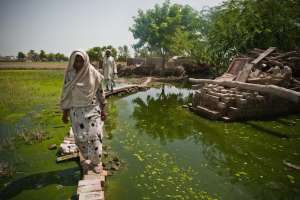
Over the past few weeks, South Asian countries have been suffering torrential rains and devastating floods and landslides, exacerbated by Cyclone Komen, leaving over 100 dead and over a million displaced from Pakistan to Myanmar. The annual monsoon season in the region, normally a lifeline for farmers, this year resulted in floods that have caused severe damage to crops.
The risks posed by floods are growing in South Asia with rising population growth, people living closer to coastlines, expanded development of coastal areas and flood plains, environmental degradation and climate change. Rising sea levels, shifting precipitation patterns, melting glaciers and other types of flash flooding due to global warming are likely to result in more frequent and intense floods in the future, and the impact of floods will be multiplied by shifting land use patterns, urbanization, and socio-economic change.
In the rush for economic development in the region, more and more factories and industrial parks are being built along low-lying coastal areas, without factoring in long-term historical data on floods and storms. Many of these businesses are at the heart of global value chains and remain exposed to business interruption losses, the same way sudden disruptions to the food supply chain could trigger a spike in food prices in the region, with potential ripple effects for the world economy.
We all know the short-term impacts of flooding: human death, damage to property and assets, loss of crops and livestock, and health deterioration due to water-borne diseases. Floods also disrupt and damage communication links and infrastructure, which in turn leads to long-term impacts such as disruptions of the clean water and electricity supply, transport, communication, education and health care.
Rice is one of the most important crops for global food security, but about 20 million hectares of rice fields in South and Southeast Asia—where most of the world’s rice is produced—are prone to flooding. In India and Bangladesh alone, more than 5 million hectares are flooded during most of the planting seasons, mainly in areas inhabited by the poor where alternative livelihood options are very limited, land is losing its value, and the young are fleeing in search of better opportunities in the city.
The costs of recovering from each flood divert funds earmarked for infrastructure and other development programs, crippling the economy of flood-prone regions even further. According to the World Resources Institute, flooding today affects 9.5 million people and costs $19.9 billion each year. By 2030, these numbers are likely to increase to over 15 million people and $215 billion, and Asia is expected to account for half of all global assets exposed to flood risks by 2070.
Disaster preparedness is therefore critical, and should include extending the reach of insurance to cover flooding. Flood insurance helps individuals, businesses and governments to get back on their feet more quickly after a disaster strikes, protects hard-won development gains, and minimizes the adverse consequences to economic growth.
To bridge the widening flood risk protection gap, we need to develop the right disaster risk financing instruments through layered coverage, linked to the severity and frequency of calamities, with insurance and capital market solutions for different risk layers.
To get the private sector on board, though, governments must be willing to:
- Create an enabling regulatory environment that allows insurers to accurately assess risk to determine premium rates that reflect the full estimated risk of potential flood losses, while still allowing the companies to make a profit.
- Provide reliable weather data to develop models to quantify catastrophic scenarios at national, regional and local levels.
- Grant insurers freedom to underwrite policies as they see fit so they can manage their risk portfolios, and offer incentives for them to assume greater risk in flood-prone areas.
- Encourage broad consumer participation in the market so insurers won’t serve only the highest-risk properties and assets, for instance by making some coverage mandatory, purchasing reinsurance from the private sector instead of borrowing from the treasury, and issuing catastrophe bonds to transfer risk.
- Promote risk awareness so businesses and households know they must be prepared, and don’t expect the government to help them when disaster strikes.
Flood risk presents significant modeling challenges when compared with earthquake risk, and in most developing countries local insurance markets are not well equipped to offer adequate cover to businesses and households. Insurance-based innovative solutions involving international reinsurers and capital markets can play a significant role in helping to identify, assess and mitigate flood risks, as well as compensate firms and individuals for losses incurred and hp rebuild infrastructure and communities.
As insurance markets mature, flood insurance schemes—whether fully public, private or a partnership between both—should be taken more into account. Both sides have their roles. The private sector will provide more flood coverage, while the public sector will promote risk awareness among consumers, encourage mitigation, enforce building codes, oversee land use agreements, and streamline insurance regulations.
In Asia, this division of responsibilities will lead to a much faster development of the ex-ante catastrophe risk financing instruments required to meet the threat of floods, with regional catastrophe pools to bundle and transfer risk, or even alternative structures like insurance-linked securities and catastrophe bonds to protect against major flood-related losses.
This article was first published by ADB Development Blog.







Comments are closed.